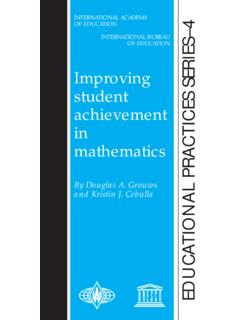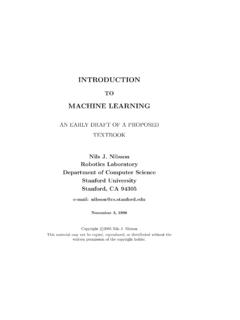Transcription of How Stereotypes Shape Intellectual Identity and Performance
1 A Threat in the Air How Stereotypes Shape Intellectual Identity and Performance Claude M. Steele stanford University A general theory of domain identification is used to de- 1965) words, as "first of all beings in a situation" such scribe achievement barriers still faced by women in ad- that if one wants to understand them, one "must inquire vanced quantitative areas and by African Americans in first into the situation surrounding [them]" (p. 60). school. The theory assumes that sustained school success The theory begins with an assumption: that to sus- requires identification with school and its subdomains; tain school success one must be identified with school that societal pressures on these groups ( , economic achievement in the sense of its being a part of one's disadvantage, gender roles) can frustrate this identifica- self-definition, a personal Identity to which one is self- tion; and that in school domains where these groups are evaluatively accountable. This accountability--that good negatively stereotyped, those who have become domain self-feelings depend in some part on good achievement-- identified face the further barrier of stereotype threat, translates into sustained achievement motivation.
2 For the threat that others' judgments or their own actions such an identification to form, this reasoning continues, will negatively stereotype them in the domain. Research one must perceive good prospects in the domain, that is, shows that this threat dramatically depresses the stan- that one has the interests, skills, resources, and opportuni- dardized test Performance of women and African Ameri- ties to prosper there, as well as that one belongs there, cans who are in the academic vanguard of their groups in the sense of being accepted and valued in the domain. (offering a new interpretation of group differences in If this relationship to schooling does not form or gets standardized test Performance ), that it causes disidenti- broken, achievement may suffer. Thus, in trying to under- fication with school, and that practices that reduce this stand what imperils achievement among women and Afri- threat can reduce these negative effects. can Americans, this logic points to a basic question: What in the experience of these groups might frustrate their identification with all or certain aspects of school achievement?
3 F. rom an observer's standpoint, the situations of a boy and a girl in a math classroom or of a Black One must surely turn first to social structure: limits student and a White student in any classroom are on educational access that have been imposed on these essentially the same. The teacher is the same; the text- groups by socioeconomic disadvantage, segregating so- books are the same; and in better classrooms, these stu- cial practices, and restrictive cultural orientations, limits dents are treated the same. Is it possible, then, that they of both historical and ongoing effect. By diminishing could still experience the c l ~ s r o o m differently, so differ- one's educational prospects, these limitations ( , inad- ently in fact as to significantly affect their Performance equate resources, few role models, preparational disad- and achievement there? This is the central question of vantages) should make it more difficult to identify with this article, and in seeking an answer, it has both a practi- academic domains.
4 To continue in math, for example, a cal and a theoretical focus. The practical focus is on the woman might have to buck the low expectations of teach- perhaps obvious need to better understand the processes ers, family, and societal gender roles in which math is that can hamper a group's school Performance and on seen as unfeminine as well as anticipate spending her what can be done to improve that Performance . The theo- entire professional life in a male-dominated world. These retical focus is on how societal Stereotypes about groups can influence the Intellectual functioning and Identity de- velopment of individual group members. To show the Editor's note. Cheryl B. Travis served as action editor for this article. generality of these processes and their relevance to im- Author's note. The research reported in this article was supportedby portant outcomes, this theory is applied to two groups: National Institutes of Health Grant MH51977, Russell Sage Foundation African Americans, who must contend with negative ste- Grant , and SpencerFoundation and James S.
5 McDonnell Foun- reotypes about their abilities in many scholastic domains, dation postdoctoral fellowships. Completion of the research was aided and women, who must do so primarily in math and the by the Center for Advanced Study in the Behavioral Sciences. physical sciences. In trying to understand the schooling Correspondence concerning this article should be addressed to Claude M. Steele, Department of Psychology, Jordan Hall, Building outcomes of these two groups, the theory has a distinct 420, stanford University, stanford , CA 94305. Electronic mail may be perspective, that of viewing people, in Sartre's (1946/ sent via Internet to June 1997 American Psychologist 613. Copyright 1997 by the American Psychological Association, Inc. 0003-066X/97/$ Vol. 52, No. 6, 613-629. becomes chronic in a situation, as for the woman who spends considerable time in a competitive, male-oriented math environment, it can pressure disidentification, a re- conceptualization of the self and of one's values so as to remove the domain as a self- Identity , as a basis of self-evaluation.)
6 Disidentification offers the retreat of not caring about the domain in relation to the self. But as it protects in this way, it can undermine sustained motiva- tion in the domain, an adaptation that can be costly when the domain is as important as schooling. Stereotype threat is especially frustrating because, at each level of schooling, it affects the vanguard of these groups, those with the skills and self-confidence to have identified with the domain. Ironically, their susceptibility to this threat derives not from internal doubts about their Claude M. ability ( , their internalization of the stereotype) but Steele from their identification with the domain and the resulting Copyright by L A. concern they have about being stereotyped in it. (This Cicero, stanford News Service, argument has the hopeful implication that to improve the domain Performance of these students, one should focus on the feasible task of rifting this situational threat rather realities, imposed on her by societal structure, could so than on altering their internal psychology.)
7 Yet, as school- reduce her sense of good prospects in math as to make ing progresses and the obstacles of structure and stereo- identifying with it difficult. type threat take their cumulative toU, more of this van- But this article focuses on a further barrier, one that guard will likely be pressured into the ranks of the un- has its effect on the already identified, those members of identified. These students, by not caring about the domain these groups who, having survived structural obstacles, vis-a-vis the self, are likely to underperform in it regard- have achieved identification with the domain (of the pres- less of whether they are stereotype threatened there. Thus, ent groups, school-identified African Americans and although the identified among these groups are likely to math-identified women). It is the social-psychological underperform only under stereotype threat, the unidenti- threat that arises when one is in a situation or doing fied (casualties of sociocultural disadvantage or prior in- something for which a negative stereotype about one's ternalization of stereotype threat) are likely to underper- group applies.
8 This predicament threatens one with being form and not persist in the domain even when stereotype negatively stereotyped, with being judged or treated ste- threat has been removed. reotypically, or with the prospect of conforming to the In these ways, then, the present analysis sees social stereotype. Called stereotype threat, it is a situational structure and Stereotypes as shaping the academic identi- t h r e a t - - a threat in the air--that, in general form, can fies and Performance outcomes of large segments of soci- affect the members of any group about whom a negative ety. But first, for the two groups under consideration, stereotype exists ( , skateboarders, older adults, White what are these outcomes? men, gang members). Where bad Stereotypes about these As is much discussed, these outcomes are in a crisis groups apply, members of these groups can fear being state for African Americans. Although Black students reduced to that stereotype. And for those who identify begin school with standardized test scores that are not with the domain to which the stereotype is relevant, this too far behind those of their White counterparts, almost predicament can be self-threatening.
9 Immediately a gap begins to appear ( , Alexander &. Negative Stereotypes about women and African Entwistle, 1988; Burton & Jones, 1982; Coleman et al., Americans bear on important academic abilities. Thus, 1966) that, by the sixth grade in most school districts, is for members of these groups who are identified with two full grade levels (Gerard, 1983). There have been domains in which these Stereotypes apply, the threat of encouraging increases in the number of African Ameri- these Stereotypes can be sharply felt and, in several ways, cans completing high school or its equivalence in recent hampers their achievement. years: 77% for Black students versus 83% for White First, if the threat is experienced in the midst of students (American Council on Education, 1995-1996). a domain Performance --classroom presentation or test- And there have been modest advances in the number taking, for e x a m p l e - - t h e emotional reaction it causes of African American high school graduates enrolling in could directly interfere with Performance .
10 My colleagues college, although these have not been as substantial as and I (Spencer, Steele, & Quinn, 1997; C. M. Steele & in other groups (American Council on Education, 1995- Aronson, 1995) have tested this possibility with women 1996). Perhaps most discouraging has been the high drop- taking standardized math tests and African Americans out rate for African American college students: Those taking standardized verbal tests. Second, when this threat who do not finish college within six years is 62%, corn- 614 June 1997 American Psychologist pared with a national dropout rate of 41% (American cans, Hispanics, and Native Americans) were as large, or Council on Education, 1995-1996). And there is evi- larger, in the upper and middle classes (as measured by dence of lower grade Performance among those who do parental education and occupation) than in the lower graduate of, on average, two thirds of a letter grade lower classes. Group differences in socioeconomic status than those of other graduating students (Nettles, 1988).





